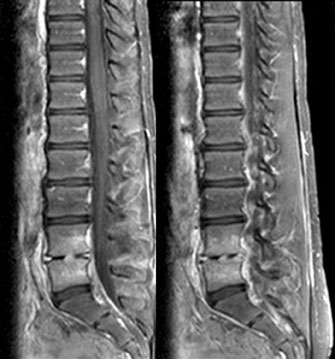11-year-old female presents with low back pain, elevated ESR

An 11-year-old female presented to the urgent care clinic with low back pain for about 1 week and was diagnosed with muscle pain. Symptomatic treatment was ineffective. She returned 6 days later and was diagnosed with “right lower back pain and sciatica.” Four days later (2 ½ weeks since onset), she was no better and was referred to orthopedics, which obtained a magnetic resonance imaging scan (MRI) (Figures 1 and 2), revealing L4–L5 discitis and osteomyelitis with a paraspinal phlegmon.

Source: Brien JH

The patient denied having any fever, chills or other complaints such as dysuria, nausea, vomiting, diarrhea, bowel or bladder control problems, numbness, tingling or any other neurologic symptoms. During the initial history, she denied any prior injury to the back or anywhere else. However, on further review of her records, it was found that she was seen 8 months earlier in the emergency room for a fall in gymnastics, with a diagnosis of “right upper back strain.” Her past medical history was otherwise unremarkable, including negative screening tests for sickle cell disease.
What's Your Diagnosis?
A. Kingella Kingae
B. Streptococcus pyogenes
C. Salmonella
D. Staphylococcus aureus
Case Discussion
Examination revealed normal vital signs and a normal appearing 11-year-old African-American female, with the only positive finding being the low back pain that radiated to the lateral right and upper right side, as well with significant guarding, as revealed in her posture. Lab tests that were performed included a normal complete blood count (CBC), C-reactive protein (CRP) of 0 and an erythrocyte sedimentation rate (ESR) of 111: her blood culture was pending.
This is a typical case of discitis with vertebral osteomyelitis of the adjacent vertebral bodies, except that it is more commonly seen in younger children (younger than 6 years). Of the above-mentioned choices, Staphylococcus aureus is the best answer, because this is the most likely cause in cases of discitis where cause is found. A history of injury is not required, but in my experience, it is often in the history. In some cases, bacteria may spread hematogenously by retrograde venous return from another site, such as the urinary tract or gut. However, this process is unclear. Older children and adults usually do not have the vascular connections to the disc that favors establishment of direct hematogenous infection, because the nutrient arteries to the disc that children have at birth usually become obliterated by the late teens and early 20s. In that circumstance, bacteria can seed the end plates of the vertebral body and subsequently spread in both directions to the body of the vertebra and to the disc.


Associated lab tests are frequently normal, but they occasionally reveal mild to moderate elevation of the inflammatory markers. Interestingly, this patient had a normal CRP but a significantly elevated ESR. Usually the condition responds well to rest alone. However, most experts recommend treatment with an anti-staphylococcal antimicrobial agent — unless the etiology is known — especially when there is vertebral body involvement noted, which is usually the case. Typical, isolated vertebral osteomyelitis usually develops from hematogenous spread of bacteria, and is often preceded by an injury, with significant overlap between the two; imaging usually reveals intact end plates and normal disk space. In children with sickle cell disease, Salmonella rises near the top of the list of infectious causes of vertebral infections. Infarction can present a similar picture.
The patient presented a significant degree of disability with pain, with involvement of the vertebral bodies. Therefore, empiric treatment with IV clindamycin and ceftriaxone was initiated, along with bed rest. On the advice of the neurosurgeon, interventional radiology attempted to obtain an organism by aspirating the area of infection (Figure 3). However, the patient had already been on IV antimicrobial therapy for 3 days at that point, and to no surprise, all stains and cultures were negative. The patient had bracing and IV antibiotics for 1 week and was sent home on oral clindamycin for another 7 weeks of therapy. At that time, the follow-up MRI revealed the chronic changes noted in Figure 4 (T2-weighted MRIs 52 days apart), with obliteration of the disc space and stabilization of the vertebral bodies. All symptoms resolved, and at 2 years of follow-up, the patient remains asymptomatic.
Again, in my experience, almost all of these patients have some history of injury if the history is pursued in detail. Also, I have not been impressed with the number of patients I have seen with concurrent infections elsewhere. Lastly, it is very common for these patients to go through various diagnoses along the way, as with this patient, who was seen a few times before, and was even thought to have sciatica at one point, a condition virtually unheard of in otherwise normal children. If sciatica or pyriformis syndrome is part of the differential diagnosis, then it is certainly time to look for discitis by MRI.
Over the years, I have featured several patients with discitis or spondylodiscitis; in January 2000, an adolescent female soccer player; in May 2006, a 2-year-old child with chronic recurrent abdominal pain; and in October 2013, an irritable infant. Please refer to these columns for more discussion.
- For more information:
- James H. Brien, DO, is with the department of infectious diseases at McLane Children’s Hospital, Baylor Scott & White Health, Texas A&M College of Medicine in Temple, Texas. He also is a member of the Infectious Diseases in Children Editorial Board. Brien can be reached at: jhbrien@aol.com.
Disclosure: Brien reports no relevant financial disclosures.
